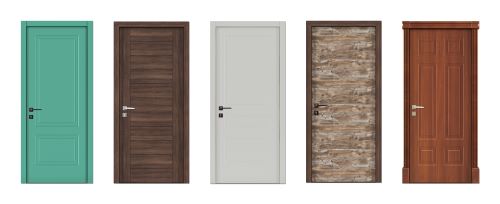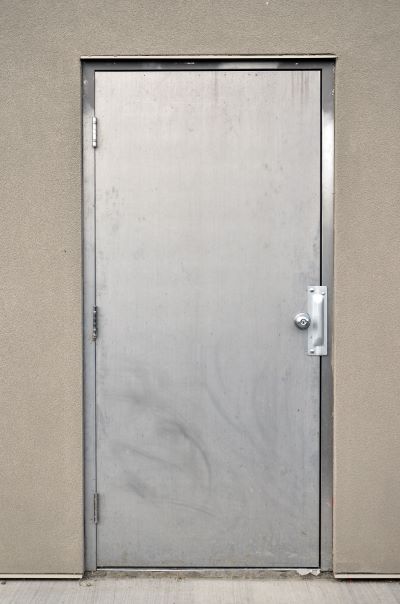No products in the cart.
How to Soundproof a Door – Interior & Exterior Door Soundproofing

28
Feb
Why Soundproof a Door?
The STC rating of a wall on its own can range from anywhere between 30-60, but if the wall also has doors and windows on it, those must also be taken into account to determine the composite STC rating of a wall. So while your wall assembly on its own may be an STC 50, the STC 21 windows and STC 25 doors are going to bring that down.
Learn More: Explaining STC – Sound Transmission Class
This is why door soundproofing is a critical part of home soundproofing. If you spent the time and money on ensuring higher STC rated walls, and then install a hollow core door without any door sweeps and seals, you’ve pretty much negated the soundproofing ability of your wall. Sound will always take the path of least resistance, so if it can’t travel through the wall, it will easily go through and around improperly soundproofed doors.
Levels of Door Soundproofing
Different types of doors have different STC ratings. For example, most interior, hollow-core doors have an STC rating between 21-25, while many exterior home doors have an STC of 40-50. Exterior apartment doors typically have an STC rating of 28-35, while the interior doors can be as low as 20.
| Door Type | STC Rating | Performance |
| Standard Hollow Core Door | 20-25 | Poor |
| Solid Core Door | 30-35 | Fair |
| Overly Metal Door | 43-57 | Very Good |
| Overly Wood Door | 41-50 | Very Good |
Soundproofing a Door – Professional vs DIY Methods
If you want to have a truly soundproof door (although it is not quite possible to get to 100%), you should invest in an STC rated door. STC Rated doors are typically required for military facilities, high-end recording studios, classrooms, and even courtrooms, but there’s nothing to stop you from installing them at home.
For a more DIY approach, where you don’t need an entirely soundproof door, consider products that you can install with your existing door, ultimately saving you some time and money.
STC Rated Doors for Noise Reduction
STC rated doors typically have more mass than your standard hollow-core or even solid-core door. They’re typically made using solid wood or metal, depending on where they’ll be installed. Most exterior STC rated doors are made from metal, while most interior STC rated doors are made using wood.
Some popular and quality STC Rated Door brands include:
It’s the combination of the mass of either the metal or wood used to make an STC rated door, with proper gasketing, that makes STC rated doors perform so much better than standard hollow-core and solid-core doors. Should you choose to invest in a high STC rated door, be sure to also purchase the proper gaskets to prevent sound leaks around the door. A 1% gap can let in up to 50% of sound, so while your door may have an STC of 50, it’ll be more like an STC 25 without gaskets installed.
DIY Door Soundproofing
While each soundproof door will run you anywhere between $1,300-$4,000, DIY door soundproofing methods should only cost about $400-$600 per door depending on which methods you choose. When soundproofing a door we always recommend starting with the easiest and cheapest options before moving onto anything more costly, especially when taking the DIY route.

- Always start with installing a door sweep at the bottom of a door. Door sweeps attach to the bottom of a door, and have a neoprene fin that should be touch the floor just enough that minimal sound leaks through, but not so much that you can’t open and close the door normally. Most noise that leaks in through a door tends to come from under the large gap beneath a door.
- If a door sweep alone doesn’t keep out as much sound as you need, consider installing door seals around the perimeter of the doorway. Some door seals are just adhesive rubber, but more heavy duty are metal with a neoprene bulb and actually need to be drilled into the frame. While the gaps around the perimeter aren’t as large as typically gaps below a door, these small spaces can still let in a significant amount of sound, so it’s still important to treat them.
- If all else fails, you still have one more option. Since most standard door are hollow-core doors, they have a very low STC in general, so even if you’ve treated the gaps around the door, sound can still travel easily through the door itself. Consider investing in a soundproof door cover. While the two options above may cost around $150 combined, a soundproof door cover is closer to $400, but it’s still more affordable than STC rated doors. Soundproofing door covers are lined with mass loaded vinyl, which on its own has an STC rating of 21, so it can add significant soundproofing abilities to your door. Basically, you’d order it in a size that completely overlaps the door. It hangs just above the door and has a perimeter seal to keep out any additional sound leaks, and works best when combined with door sweeps and seals.
How to Soundproof a Door – The Ultimate Guide
As we discussed above, there are a few options you have when soundproofing a door, and some important factors to consider include cost and the amount of labor involved. Ultimately, if you have the budget for it, you should consider investing in replacing all of your hollow-core doors with either solid-core doors or STC rated doors with gasketing. However, if your noise problems aren’t too bad and you’re more interested in an affordable, DIY approach, then consider door sweeps, door seals and a soundproofing door cover.
